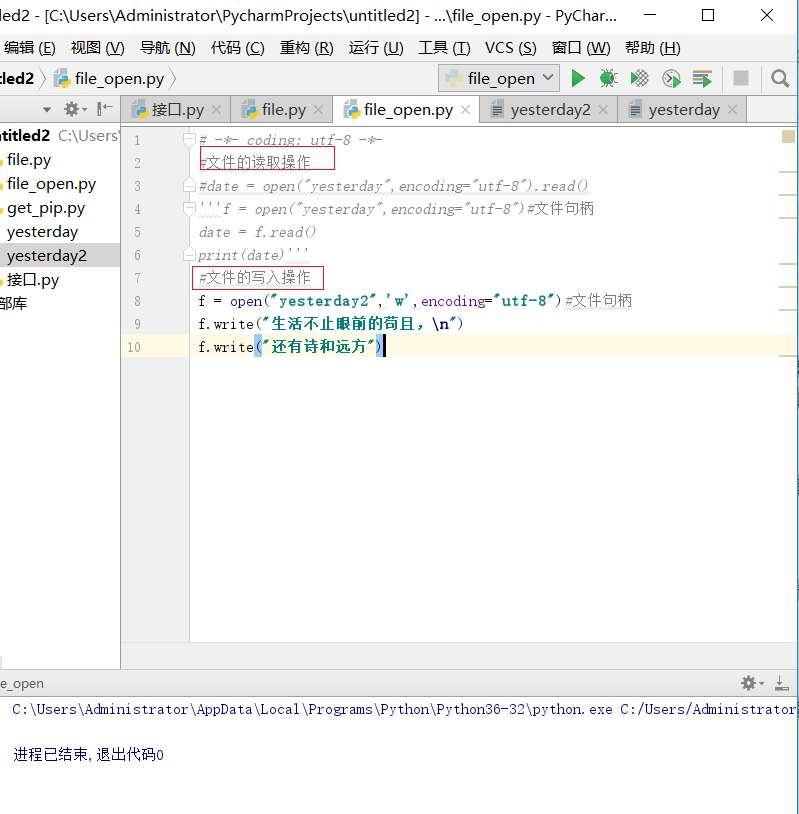python对文件操作
Posted 众里寻他千百度。蓦然回首,那人却在,灯火阑珊处。——韦大仙
tags:
篇首语:本文由小常识网(cha138.com)小编为大家整理,主要介绍了python对文件操作相关的知识,希望对你有一定的参考价值。
文件操作:
对文件操作流程
- 打开文件,得到文件句柄并赋值给一个变量
- 通过句柄对文件进行操作
- 关闭文件
现有文件如下
Somehow, it seems the love I knew was always the most destructive kind
不知为何,我经历的爱情总是最具毁灭性的的那种
Yesterday when I was young
昨日当我年少轻狂
The taste of life was sweet
生命的滋味是甜的
As rain upon my tongue
就如舌尖上的雨露
I teased at life as if it were a foolish game
我戏弄生命 视其为愚蠢的游戏
The way the evening breeze
就如夜晚的微风
May tease the candle flame
逗弄蜡烛的火苗
The thousand dreams I dreamed
我曾千万次梦见
The splendid things I planned
那些我计划的绚丽蓝图
I always built to last on weak and shifting sand
但我总是将之建筑在易逝的流沙上
I lived by night and shunned the naked light of day
我夜夜笙歌 逃避白昼赤裸的阳光
And only now I see how the time ran away
基本操作
f = open(\'lyrics\') #打开文件
first_line = f.readline()
print(\'first line:\',first_line) #读一行
print(\'我是分隔线\'.center(50,\'-\'))
data = f.read()# 读取剩下的所有内容,文件大时不要用
print(data) #打印文件
f.close() #关闭文件
打开文件的模式有:
- r,只读模式(默认)。
- w,只写模式。【不可读;不存在则创建;存在则删除内容;】
- a,追加模式。【可读; 不存在则创建;存在则只追加内容;】
"+" 表示可以同时读写某个文件
- r+,可读写文件。【可读;可写;可追加】
- w+,写读
- a+,同a
"U"表示在读取时,可以将 \\r \\n \\r\\n自动转换成 \\n (与 r 或 r+ 模式同使用)
- rU
- r+U
"b"表示处理二进制文件(如:FTP发送上传ISO镜像文件,linux可忽略,windows处理二进制文件时需标注)
- rb
- wb
- ab
其它语法
def close(self): # real signature unknown; restored from __doc__
"""
Close the file.
A closed file cannot be used for further I/O operations. close() may be
called more than once without error.
"""
pass
def fileno(self, *args, **kwargs): # real signature unknown
""" Return the underlying file descriptor (an integer). """
pass
def isatty(self, *args, **kwargs): # real signature unknown
""" True if the file is connected to a TTY device. """
pass
def read(self, size=-1): # known case of _io.FileIO.read
"""
注意,不一定能全读回来
Read at most size bytes, returned as bytes.
Only makes one system call, so less data may be returned than requested.
In non-blocking mode, returns None if no data is available.
Return an empty bytes object at EOF.
"""
return ""
def readable(self, *args, **kwargs): # real signature unknown
""" True if file was opened in a read mode. """
pass
def readall(self, *args, **kwargs): # real signature unknown
"""
Read all data from the file, returned as bytes.
In non-blocking mode, returns as much as is immediately available,
or None if no data is available. Return an empty bytes object at EOF.
"""
pass
def readinto(self): # real signature unknown; restored from __doc__
""" Same as RawIOBase.readinto(). """
pass #不要用,没人知道它是干嘛用的
def seek(self, *args, **kwargs): # real signature unknown
"""
Move to new file position and return the file position.
Argument offset is a byte count. Optional argument whence defaults to
SEEK_SET or 0 (offset from start of file, offset should be >= 0); other values
are SEEK_CUR or 1 (move relative to current position, positive or negative),
and SEEK_END or 2 (move relative to end of file, usually negative, although
many platforms allow seeking beyond the end of a file).
Note that not all file objects are seekable.
"""
pass
def seekable(self, *args, **kwargs): # real signature unknown
""" True if file supports random-access. """
pass
def tell(self, *args, **kwargs): # real signature unknown
"""
Current file position.
Can raise OSError for non seekable files.
"""
pass
def truncate(self, *args, **kwargs): # real signature unknown
"""
Truncate the file to at most size bytes and return the truncated size.
Size defaults to the current file position, as returned by tell().
The current file position is changed to the value of size.
"""
pass
def writable(self, *args, **kwargs): # real signature unknown
""" True if file was opened in a write mode. """
pass
def write(self, *args, **kwargs): # real signature unknown
"""
Write bytes b to file, return number written.
Only makes one system call, so not all of the data may be written.
The number of bytes actually written is returned. In non-blocking mode,
returns None if the write would block.
"""
pass
with语句
为了避免打开文件后忘记关闭,可以通过管理上下文,即:
with open(\'log\',\'r\') as f:
...
如此方式,当with代码块执行完毕时,内部会自动关闭并释放文件资源。
在Python 2.7 后,with又支持同时对多个文件的上下文进行管理,即:
with open(\'log1\') as obj1, open(\'log2\') as obj2:
pass
以上是关于python对文件操作的主要内容,如果未能解决你的问题,请参考以下文章
我在哪里更改此 Python 代码片段以将临时文件保存在 tmp 文件夹中?

